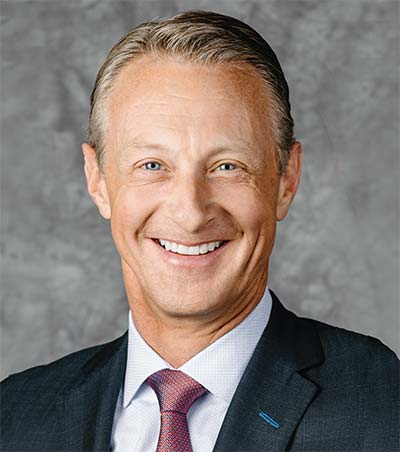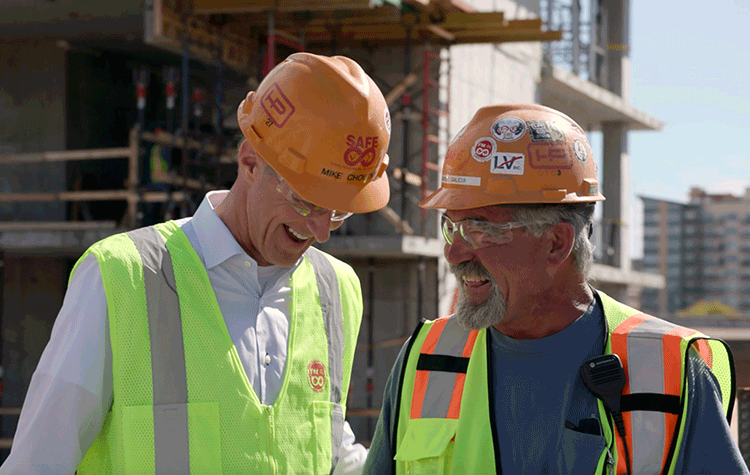2021 CEOs Who 'Get It'


Mike Choutka
President and CEO
Hensel Phelps
Greeley, CO
Founded in 1937, Hensel Phelps specializes in building development, construction and facility services in a range of markets, from aviation to government, commercial, transportation, critical facilities, health care and transportation. Hensel Phelps is one of the largest employee-owned general contractors in the United States. Hensel Phelps brings clients’ vision to life with a comprehensive approach that begins with innovative planning and extends throughout the entire life of the property. The organization has 3,905 employees.

Describe your personal journey to becoming a CEO who “gets it.”
I began my career with Hensel Phelps almost 30 years ago as a field engineer, working on a multi-prime aviation project. One day, I was in the field performing survey work, minding my own business. There was another contractor making a crane pick nearby that was not properly planned. The crane operator lost control of the load, which struck me at a high rate of speed. I was not severely injured, although it could have been much worse. At that early point in my career, I learned how inherently dangerous this industry can be and how important hazard analysis is in the planning process. I also learned that engineering controls were not the sole remedy to preventing all incidents. People make the difference in this industry, so a strong safety culture with high engagement is needed for a holistic approach to a zero-accident mentality.
From that moment until present day, I can honestly say getting injured on a jobsite was one of the lowest points of my career. I do not want anyone to go through that experience on a Hensel Phelps project.
What is the biggest obstacle to safety at your organization, and how do you work to overcome it?
The construction industry faces challenges every day that create barriers for safety culture, including trade partner integration, difficult schedules, budget constraints and complex projects. Considering these obstacles, our biggest challenge is creating an uncompromising safety culture that is consistent on all of our projects and engages everyone from the moment they walk onto our project.
Our goal is to be the safest company in our industry. To achieve this goal, we start by creating a culture that engages all stakeholders. We focus on three guiding principles: visible leadership involvement, engaging all employees and trade partners, and recognizing people for the things they do well every day. For us to be successful, we need to have safety champions on each project who build relationships with our people and trade partners. We send a consistent message that safety is of the highest importance. We must all do what we say, even when the challenges of the project make it difficult.
Why is safety a core value at your organization?
Hensel Phelps places the highest value on the safety and health of our employees, trade partners and our communities. I truly believe that safety is the most important thing we do because we care about our people and their families. Our leadership understands that every decision made sends a message about what really matters to the organization and impacts employee behavior. For us to demonstrate that safety really is this important, we must integrate safety into everything we do, ensure the right plans and controls are in place before performing any operation, verify safe working conditions, and empower anyone to stop work when conditions change.
How do you instill a sense of safety in employees on an ongoing basis?
Our commitment to safety begins immediately for each new hire or trade partner when they come to our project during our orientation program. Following that, we need to be consistently messaging safety to demonstrate our commitment. It is critical that we communicate our safety philosophy and expectations, not only when an employee is first hired, but at frequent touch points. Each new day and new task begins with a safety message. We require that our people are engaged in our safety observation program to identify and correct safety concerns and unsafe behavior.
A successful safety culture needs the commitment and engagement of all stakeholders. Focusing on our guiding principle of visible leadership involvement, we mandated that executive leadership walk each of their projects for “safety only” visits. The increased focus of safety from our most senior leadership sent a clear message to all personnel that safety mattered at the highest level of the organization. We engage the owners of our trade partners by holding Executive Safety Culture Charrettes on each site to proactively talk about the safety performance of the project, set expectations and to further demonstrate the importance of safety to Hensel Phelps.
To enhance craft engagement, last year we launched our Craft Awareness and Recognition in Safety (CARES) Program. This program directly involves the craft in safety decisions and provides a forum for the CARES members to meet with project management. This program has been monumental in creating a collaborative partnership between the trades and our management. It is also furthering our safety culture on the project and across industry.
“CARES has helped change the safety culture for the better. It shows the craft their opinion matters,” remarked one of CARES team member when asked how the program has changed the safety culture on their project. We have also been encouraged to see this program being led by a trade partner craft on certain projects.
How does your organization measure safety? What are the leading indicators that show you how safe your organization is, and where do you see room for improvement?
Organizations need to understand where their injuries are occurring and identify underlying trends so they can affect change. By tracking injury information and other key metrics, we can see if our efforts are making a difference regarding injury frequency and severity. It also indicates the effectiveness of our program.
Our approach was to make the data tell a story that drives change. We created dashboards for our people that incorporate both leading and lagging indicators in a visual format that is sortable by location, supervisor, activity, near misses, trade partners, vehicle accidents and cost. Our leading indicator information includes participation and trends in our observation program and 25 key performance indicators that are independently assessed using a third-party provider.
We are currently trying to improve the amount of leading indicator information available for our project teams by moving all our processes to an electronic format. The result will create a project dashboard showing the status of all safety-related items such as inspections, permits and tailgate meetings, making our people more efficient and creating safer projects.
What role does off-the-job safety play in your organization’s overall safety program? What types of off-the-job safety and health programs does your organization offer to employees?
We ask our employees to bring our message of safety home to their families through our annual safety calendar coloring contest. We have found that having an annual event where our employees have conversations with their children about how they stay safe at work makes safety personal and is a powerful reminder to our people about what is really important. The children create original artwork with a safety message and the winners are featured in our annual safety calendar – given to every employee. We also use the calendar to highlight our craft team members’ contributions to safety on their project.
Another area of focus is fleet safety. We provide defensive driver training to all employees. For many of us, driving is the most dangerous thing we do every single day – whether at work or in our personal lives. We also realized that most people do not get refresher training in how to drive safely once they get a license, so it is important that we do our best to give our people skills to keep them, their families and communities safe.
What have you done to support employee mental health and well-being within your organization?
We recognize that the construction industry has one of the highest rates of suicide among all other industries. Additionally, many of us, or someone close to us, will experience a mental health issue during our lifetime. This topic is critically important today with the current challenges all of us are facing in our daily lives. To address the issues of mental health and suicide prevention, we launched “Culture of Care.” Culture of Care is a program that provides resources, educational information and tools to support our people and their families. We created a website for our employees with all of our mental health resources, including the employee assistance program, crisis phone numbers, tailgate topics, a mental health screening tool, posters and other educational materials.
Post a comment to this article
Safety+Health welcomes comments that promote respectful dialogue. Please stay on topic. Comments that contain personal attacks, profanity or abusive language – or those aggressively promoting products or services – will be removed. We reserve the right to determine which comments violate our comment policy. (Anonymous comments are welcome; merely skip the “name” field in the comment box. An email address is required but will not be included with your comment.)


